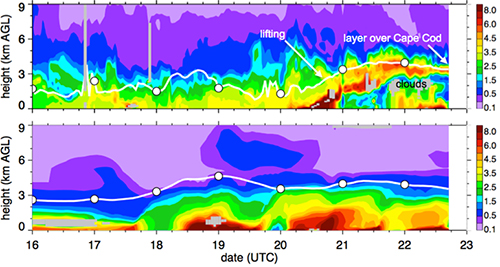Unraveling the layers of aerosols in the atmosphere
Submitter:
Fast, Jerome D — Pacific Northwest National Laboratory
Area of research:
Aerosol Processes
Journal Reference:
Science
Previous studies have shown that there are large errors in the characteristics of simulated aerosol particle layers in global models that subsequently contribute to uncertainties in radiative forcing calculations. Understanding the processes that contribute to the vertical distribution of aerosols is the necessary first step to better represent the relevant atmospheric processes in climate models.
Impact
The analysis allows other researchers to understand the impact of mean vertical motions on the vertical distribution of aerosols in the atmosphere. Much attention has been placed on the role of rapid vertical transport associated with boundary-layer turbulence and convective clouds, but slower vertical transport associated with synoptic-scale (large-scale) weather systems is often neglected. The research shows that the coarse spatial resolution normally used in global climate models likely underestimates the magnitude of mean vertical motions in the atmosphere, and consequently leads to an under-prediction of aerosol concentrations in the free troposphere. The higher-resolution model produced stronger vertical motions and better captured the structure of aerosol layers and aerosol concentrations in the free troposphere. The researchers noted that the next-generation climate models that use “regionally refined” domains will not entirely solve the problem of misrepresenting aerosol layers since a large fraction of the global domain would still employ relatively coarse resolution.
Summary
Research led by Department of Energy scientists at Pacific Northwest National Laboratory identified the atmospheric processes responsible for the structure and composition of the aerosols layer using extensive in situ and remote-sensing measurements collected during the 2012 Two-Column Aerosol Project (TCAP). The goal of the TCAP campaign was to sample aerosol microphysical properties in two columns; one fixed column near the Cape Cod National Seashore’s Highlands Center on the eastern shore of Cape Cod, Massachusetts and another movable column several hundred kilometers over the Atlantic Ocean. Aerosol layers were observed on every flight conducted by the research aircraft, although the altitude, thickness, and aerosol concentrations varied each day. A key challenge was to understand the reason for this variability in the aerosol layers, particularly those located in free troposphere several kilometers above the surface, and identify the source of these aerosols. This research showed that a higher-resolution regional model produced more aerosol mass in the free troposphere than a coarser-resolution global climate model, so that the fraction of aerosol optical thickness in the free troposphere was more consistent with lidar measurements. Simulated aerosol layers in the free troposphere were largely the result of mean vertical motions that transport aerosols from the top of the boundary layer to higher altitudes. The vertical displacement and the time period associated with upward transport in the troposphere depend on the strength of the synoptic system and whether relatively high boundary-layer aerosol concentrations are present where convergence occurs. While a parameterization of subgrid-scale convective clouds modulated the concentrations of aerosols aloft, it did not significantly change the overall altitude and depth of the layers.


